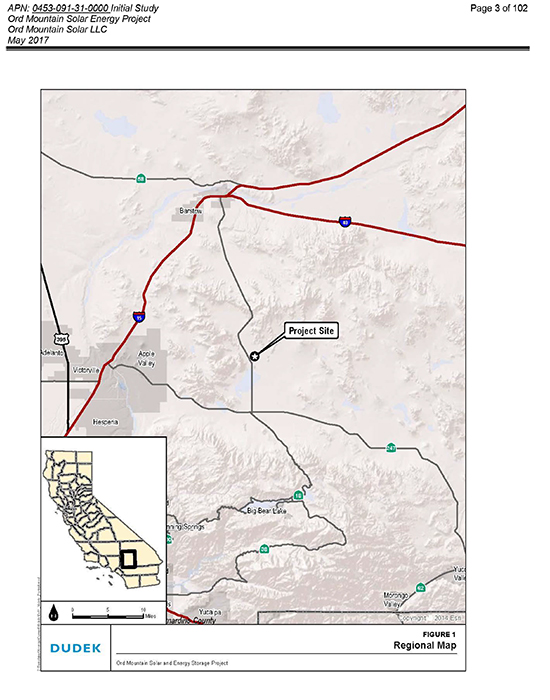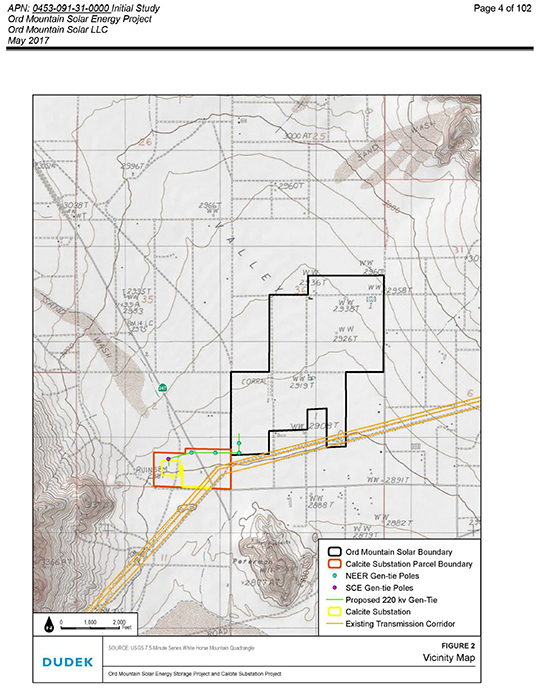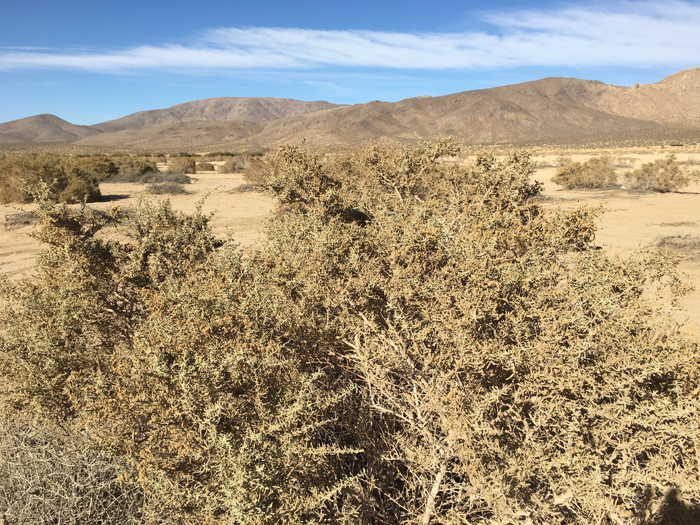^Fourwing saltbush (Atriplex canescens) community near the Granite Mountains, adjacent to the proposed Ord Mountain Solar Project.
Ord Mountain Solar Would Block Connectivity
June 28, 2017 - Lucerne Valley CA - The Ord Mountain Solar Project would be located on 485 acres of land just north of Lucerne Valley, California. It would remove Mojave Desert natural communities and be constructed within 50 feet of some homes. The project would produce 60 MW and would have a 35,000 square foot battery storage building. Because temperatures get so hot in Lucerne Valley in the summer, the building will require air conditioning. The question is, how much power will be used up to cool the building with the batteries? Why not use rooftops instead, especially rooftops in coastal cities and load centers? Individual batteries can stay cool in homes.
Wildlife Connectivity
The project is proposed to be placed right in part of the the linkage from the San Bernardino Mountains north to the Granite Mounatins and Ord Mountains, as well as to the Superior-Cronese tortoise critical habitat, part of the network of West Mojave Desert connectvity corridors. Basin & Range Watch has talked with several residents and local biologists who have seen desert bighorn sheep crossing Fifteen Mile Valley and in other nearby areas. The Ord Mountains has a good population of bighorn.
SCE wants a new large substation to serve this solar project (thus opening up a scenario of cumulative impacts by drawing in more utlity-scale solar projects to this rural region): the Calcite Substation to this project would be 165 acres located along the scenic 247 highway. This again would clutter a connectivity corridor for bighorn sheep and desert tortoise.
Desert tortoise move through this area from the south into the Ord-Rodman Desert Wildlife management Area--critical habitat for the federally Threatened reptile.
Bendire's Thrasher Area of Critical Environmental Concern lies adjacent to the project sites, in the Granite Mountains.
Golden eagles nest in the Granite Mountains, and need these surrounding flat deserts to hunt and forage for jackrabbits and other prey.


San Emigdio Blue Butterfly
There is a rare butterfly, the San Emigdio blue (Plebejus emigdionis) that requires saltbush (Atriplex) as its host plant. It has a special relationship with the mound ant (Formica francoeuri). The butterfly lays a single egg on four-wing saltbush leaves (Atriplex canescens). Caterpillars eat the saltbush leaves and are tended to by the ants which harvest honeydew from the larvae. Older caterpillars overwinter in the soil. Building industrial solar projects in Atriplex habitats in this area could destroy this delicate ecology.
The San Emigdio blue is very rare and local in southern California from Inyo County south through the Mojave Desert, San Joaquin Valley, Bouquet and Mint Canyons, and Los Angeles County. Its NatureServe Global Status is G3 - Very rare or local throughout its range or found locally in a restricted range (21 to 100 occurrences), and therefore considered threatened throughout its range. The US Fish and Wildlife Service has considered it as a candidate species for listing under the Endangered Species Act.
The area should be surveyed for the butterfly, and if it is present, a compensatory mitigation plan should be decided on. Better yet, this project should not be built here, but better alternatives of Community Choice Aggregate and community solar projects in places where the local community chooses, should be the preferred alternative.
Description of the Project
Ord Mountain Solar, LLC proposes a Conditional Use Permit to construct and operate a solar energy generation and storage project on approximately 484 acres to produce approximately 160,000 megawatt-hours of renewable energy annually. The project would be a 60-Megawatt (MW) alternating current (AC) photovoltaic solar energy facility with associated on-site substation, inverters, fencing, roads, and supervisory control and data acquisition (SCADA) system. The project would include a 60 MW AC maximum capacity, 4-hour energy storage battery system, and a 220-kilovolt overhead power line, referred to as a generation tie line (gen-tie line), which would extend approximately 0.6 mile southwest to SCE’s proposed Calcite Substation (also part of the project), in close proximity to the existing high-voltage transmission corridor. The project includes a Major Variance to modify the maximum structure height to permit the construction of onsite transmission poles and related structures up to 94 ft. in height.
Comment
Comments and questions should be directed as follows, before 4:30 p.m. on June 30, 2017:
County of San Bernardino Land Use Services Department John Oquendo, AICP Senior Planner 15900 Smoke Tree Street, Suite 131 Hesperia, CA 92345 Phone: (760) 995-8153 Email: John.Oquendo@lus.sbcounty.gov
http://www.sbcounty.gov/uploads/lus/Desert/NoticeofPreparationP201600510OrdMountainSoar.pdf
http://www.sbcounty.gov/ uploads/lus/Desert/FINALOrdMtnInitialStudyp201600 510.pdf

